Complete Solutions to Exercise of chapter CAPACITANCE of Class 12 book with complete answers and questions
| Class 12 | PHYSICS |
| Chapter | CAPACITANCE |
| CP SINGH | Exercise |
| Number Of Questions | 74 |
| Academic Year | 2023-24 |
The capacitance of a capacitor depends on
(A) Charge on the plates
(B) the size of the plates
(C) the shape of the plates
(D) the separation between the plates02:30View SolutionConsider a parallel plate capaciter having plates of unequal area. When a battery supplies `+Q_(1)` and `-Q_(2)` charges to two plates.
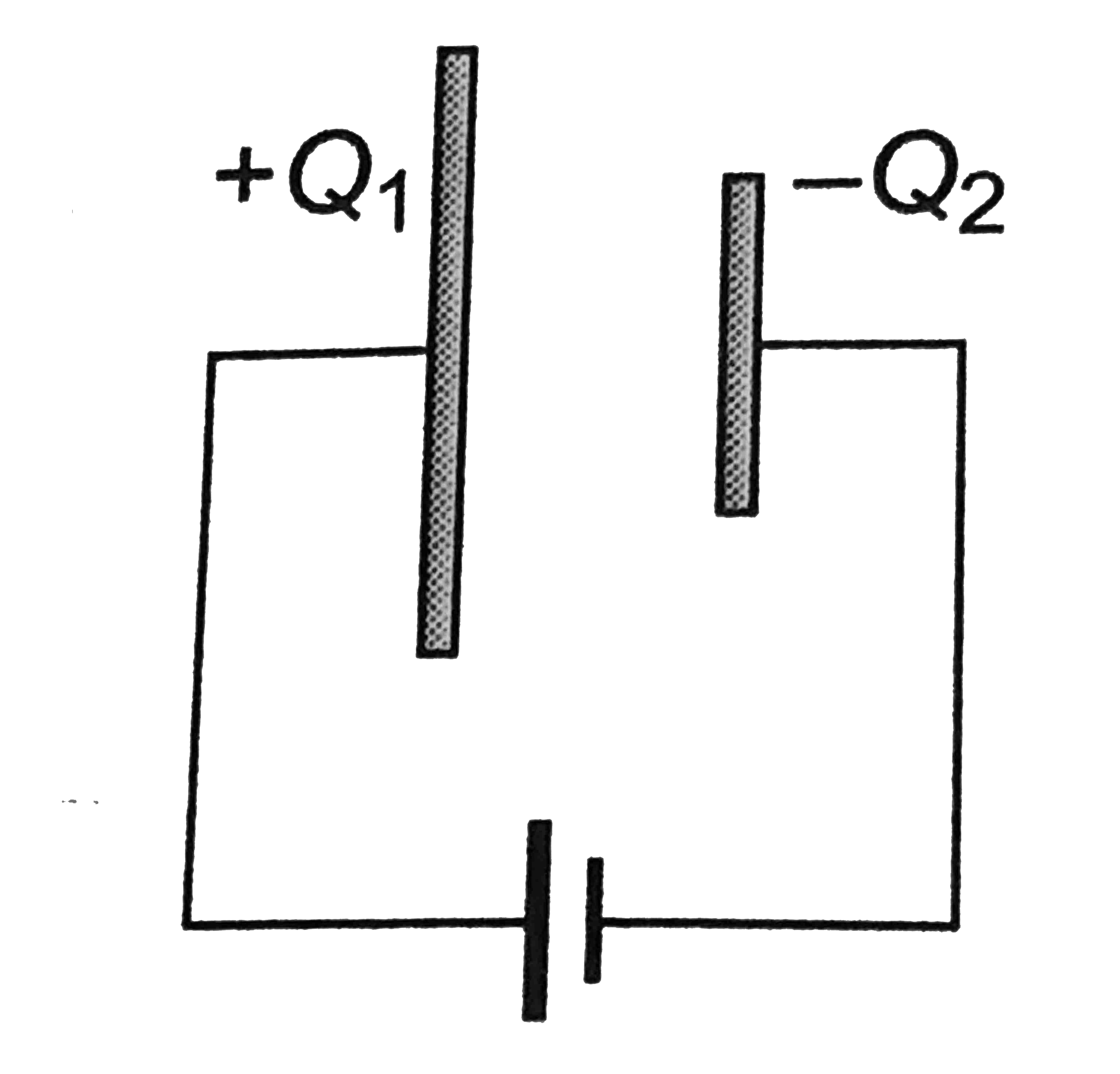 02:00View Solution
02:00View SolutionThe magnitude of electric field `vecE` in the annular region of a charged cylindrical capacitor.
04:05View SolutionThe energy required to charge a parallel plate condenser of plate separtion `d` and plate area of cross-section `A` such that the unifom field between the plates is `E` is
05:16View SolutionIf the distance between the plates of parallel plate capacitor is halved and the dielectric constant of dielectric is doubled, then its capacity will
01:40View SolutionThe capacity of a parallel plate capacitor with no dielectric substance but with a separation is reduced to half and it is filled with a dielectirc substance of value `2.8`. The final capacity of the capacitor is
02:35View SolutionForce acting upon charged particle kept between the plates of a charged condenser is `F`. If one of the plates of the condenser is removed, force acting on the same particle will become.
01:30View SolutionIf the plates of a capacitor are joined together by as conducting wire, then its capacitance
01:21View SolutionThe plates of a parallel plate capacitor are pulled apart with a velocity `v`. If at any instant their mutual distance of separation is `x`, then magnitude of rate of change of capacitance with respect to time varies as
03:09View SolutionA parallel plate capacitor has a plate separation of `2mm` and use a dielectric (whose dielecric strength is `200 kV//cm)` as an insulator. The maximum potential difference that can be applied to the terminals of the capacitor is
01:31View SolutionA metal plate of thickness half the separation between the capacitor plates of capacitance `C` is inserted. The new capacitance is.
01:54View SolutionIn a capacitor of capacitance `20 muF`,the distance between the plates is `2 mm`. If a dielectirc slab of width `1 mm` and dielectric constant `12` is inserted between the plates, then the new capacitance is
02:31View Solution`n` idential capacitors each of capacitance `C` when connected in series give equivalent capacitance `1.2muF` and when connect in parallel give `120muF`. Then `n` and `C` are
02:35View SolutionThree capacitors each of capacity `4 muF` are to be connected in such a way that the effective capacitance is `6 muF`. This can be done by
01:41View SolutionIn how many ways one can arrange three idential capacitors taking either one or two or three capacitors together to obtain distinct effective capacitance is
01:46View SolutionConsider three capacitors of capacitance `C_(1),C_(2)` and `C_(3)`. If `C_(1), C_(2)` and `C_(3)` in parallel, the equivalent capacitance is `6` unit, while `C_(2)` and `C_(3)` in parallel, the equivalent capacitance is `5` unit. If `C_(1).C_(2).C_(3)=6`, then the capacitance are
03:41View SolutionA series combination of `n_(1)` capacitors, each of value `C_(1)`, is charged by a source of potential difference `4 V`. When another parallel combination of `n_(2)` capacitors, each of value `C_(2)`, is charged by a source of potential difference `V`, it has same (total) energy stored in it, as the first combination has. the value of `C_(2)`, in terms of `C_(1)`, is then
03:29View SolutionThe voltage of clouds is `4 xx 10^(6) V` with respect to ground. In a lighting strike lasting `100 ms`, a charge of `4 C` is delivered to the ground. The power of ligthing strike is
03:14View SolutionIn an isolated parallel plate capacitor of capacitance `C`, the plates have charge `Q_(1)` and `Q_(2)`. The potential difference between the plates is
03:20View SolutionIn an isolated parallel plate capacitor of capacitancee `C`, the four surface have chrges `Q_(1),Q_(2),Q-(3)` and `Q_(4)` as shown. The potential difference between the plates is
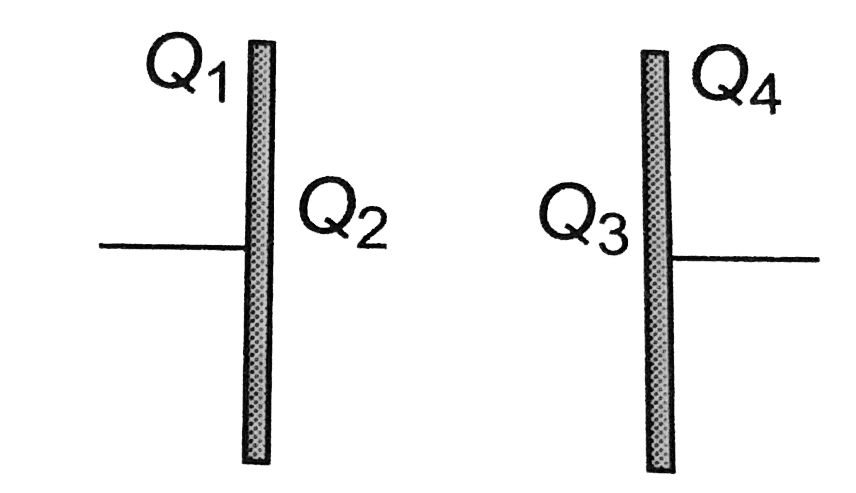 02:27View Solution
02:27View SolutionMinimum number of capacitors of `4muF` capacitance each required to obtain a capacitor of `10muF` will be
01:42View SolutionA parallel plate air capacitor has a capacitance `C`. When it is half filled with a dielectric `(K=2)`, the percentage increase in the cpacitance will be
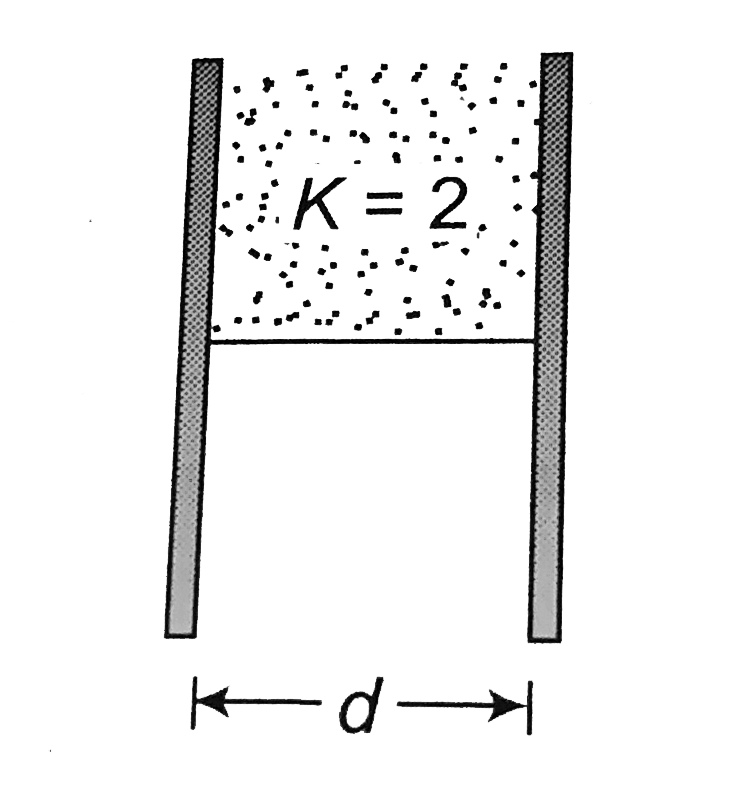 02:50View Solution
02:50View SolutionA parallel plate capacitor with air between the plates has capacitance of `9pF`. The separation between its plates is 'd'. The space between the plates is now filled with two dielectrics. One of the dielectrics has dielectric constant `k_1=3` and thickness `d/3` while the other one has dielectric constant `k_2=6` and thickness `(2d)/(3)`. Capacitance of the capacitor is now
05:27View SolutionA parallel plate capacitor with vacuum between its plates has capacitance `C`. A slabe of dielectric constant `K` and having the same thickness as the separation between the plates is introduced so as to fill `1//3^(rd)` of the capacitor as shown in the figure. the new capacitance will be
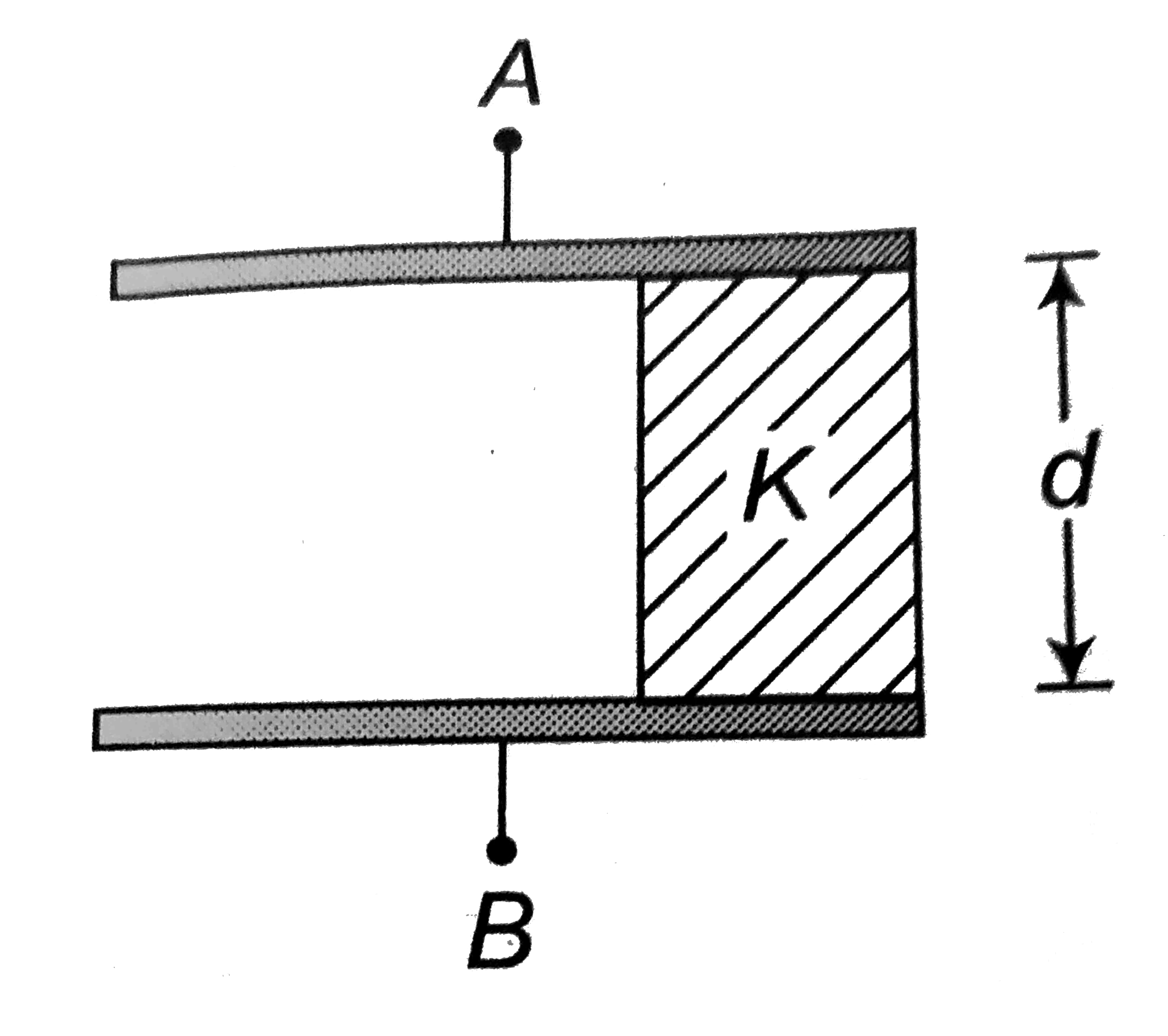 03:08View Solution
03:08View SolutionIn the following circuit, the resultant capacitance between `A` and `B` is `1muF`. Then value of `C` is
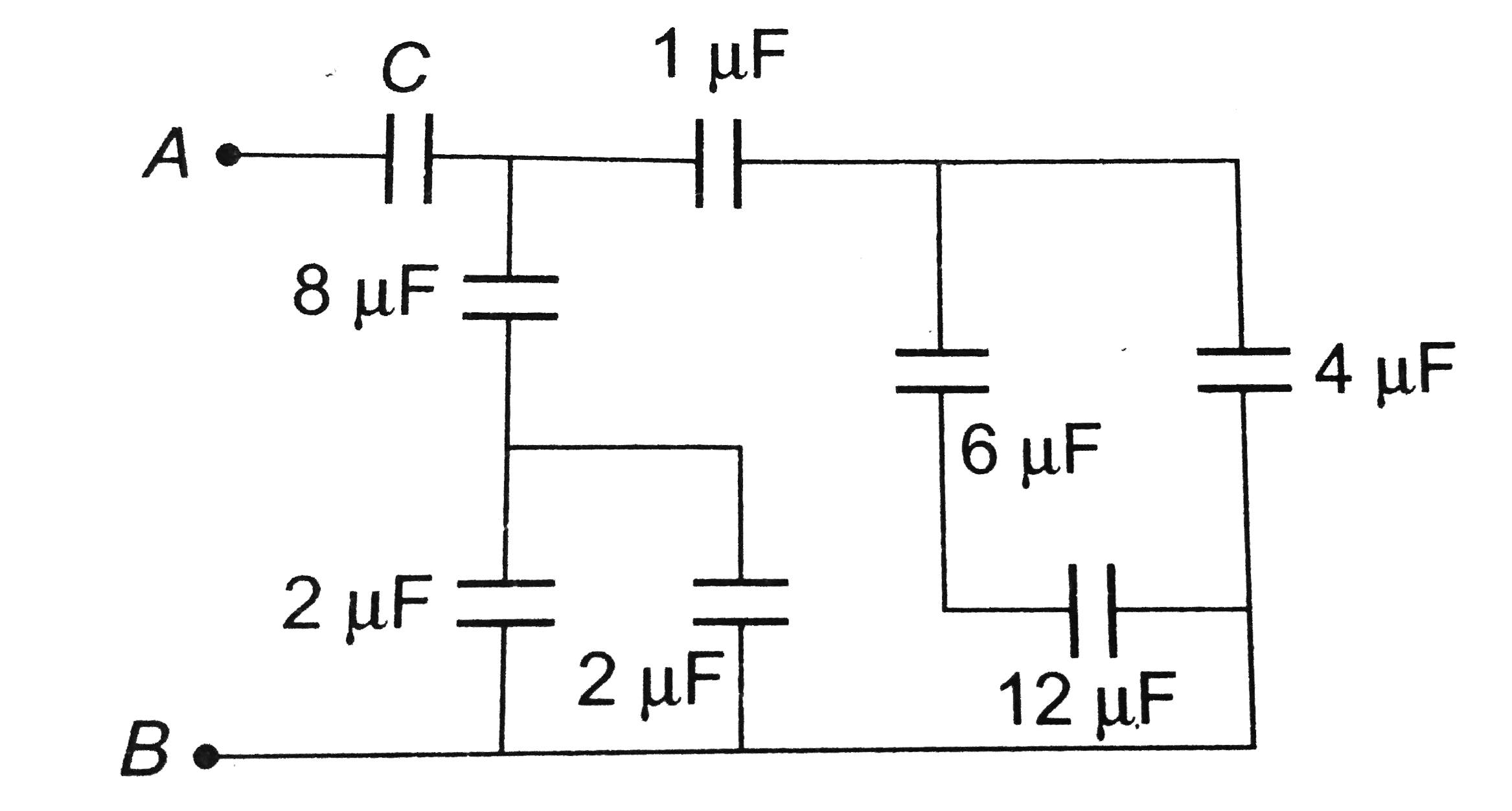 04:34View Solution
04:34View SolutionA finite ladder is constructed by connecting several sections of `3 muF,6 muF` capacitor combination as shown. The value of `C` such that the equivalent capacitance of ladder between the points `A` and `B` becomes independent of the number of section in between
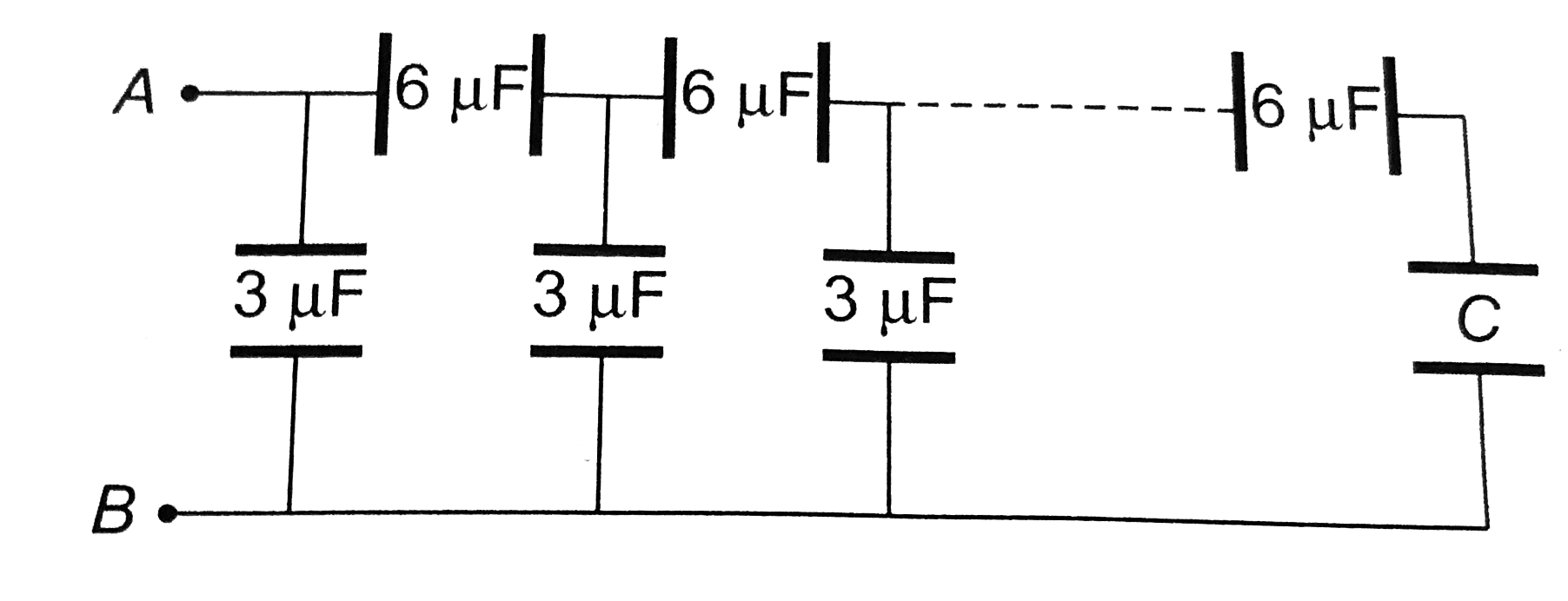 03:30View Solution
03:30View SolutionTwo spherical conductors `A` and `B` radii `r` and `R(Rgtr)` are placed in air concentrically `B` is given charge `+Q` and `A` is grounded. The equivalent capacitance of these is
 View Solution
View SolutionConsider the following diagram,
consider the following statements
(i) charge on `C_(1)`=charge on `C_(2)+` charge on `C_(3)`
(ii) `p.d`.across `C_(1)=p.d`.across `C_(2)+p.d`.across `C_(3)`
(iii) Energy stored in `C_(1)`=energy stored in `C_(2)+` Ebergy stored in `C_(3)`
 06:25View Solution
06:25View SolutionA network of four capacitors of capacity equal to `C_(1) = C, C_(2) = 2C, C_(3) = 3C` and `C_(4) = 4C` are connected to a battery as shown in the figure. The ratio o fthe charges on `C_(2)` an `C_(4)` is
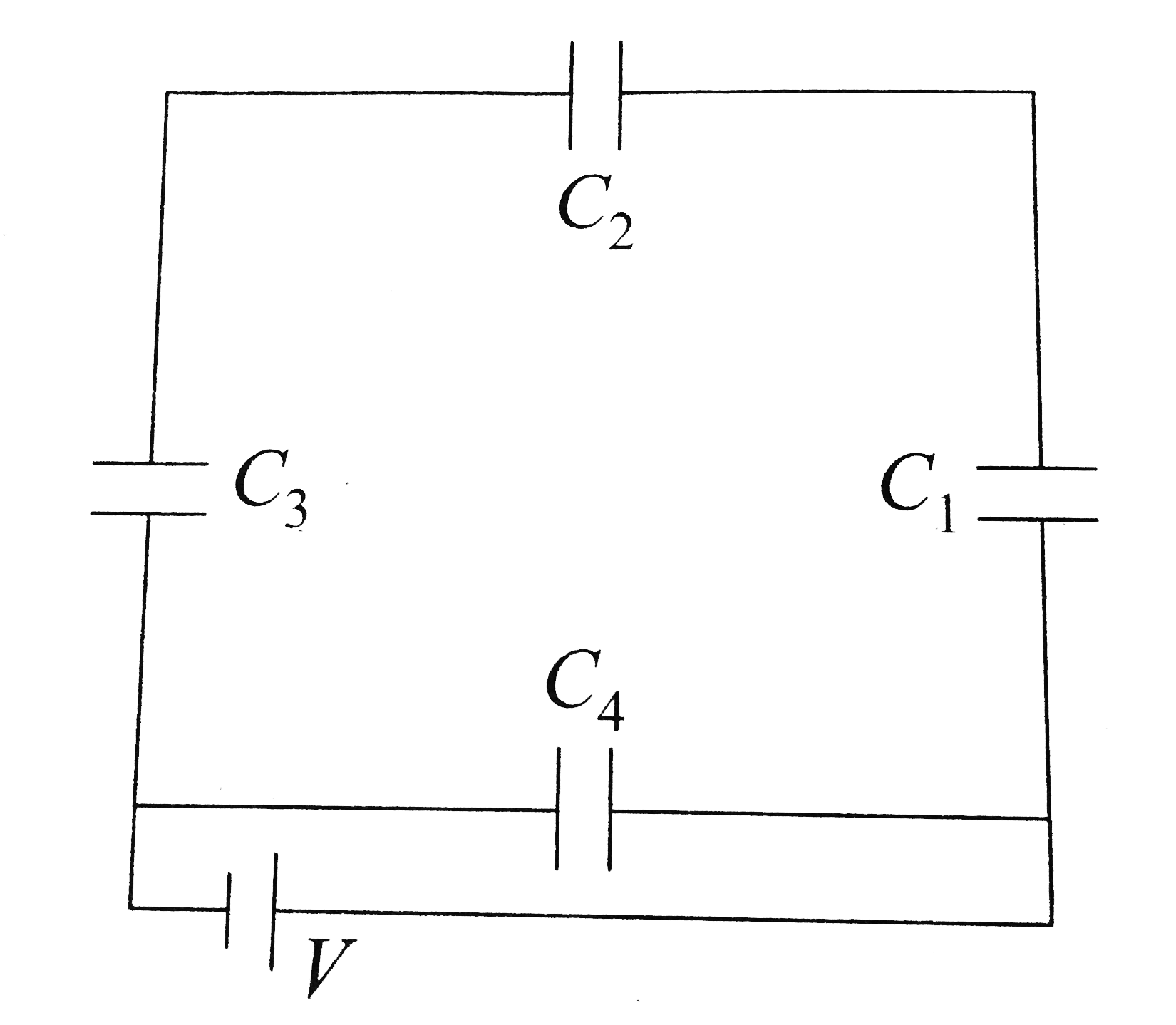 03:44View Solution
03:44View SolutionIn the given circuit, a charge of `+80muC` is given to the upper plate of the `4muF` capacitor. Then in the steady state, the charge on the upper plate of the `3muF` capacitor is
 04:01View Solution
04:01View SolutionConsider the situation as shown in figure. The variation of potential as one moves from left to right along branch containing the capacitors, if
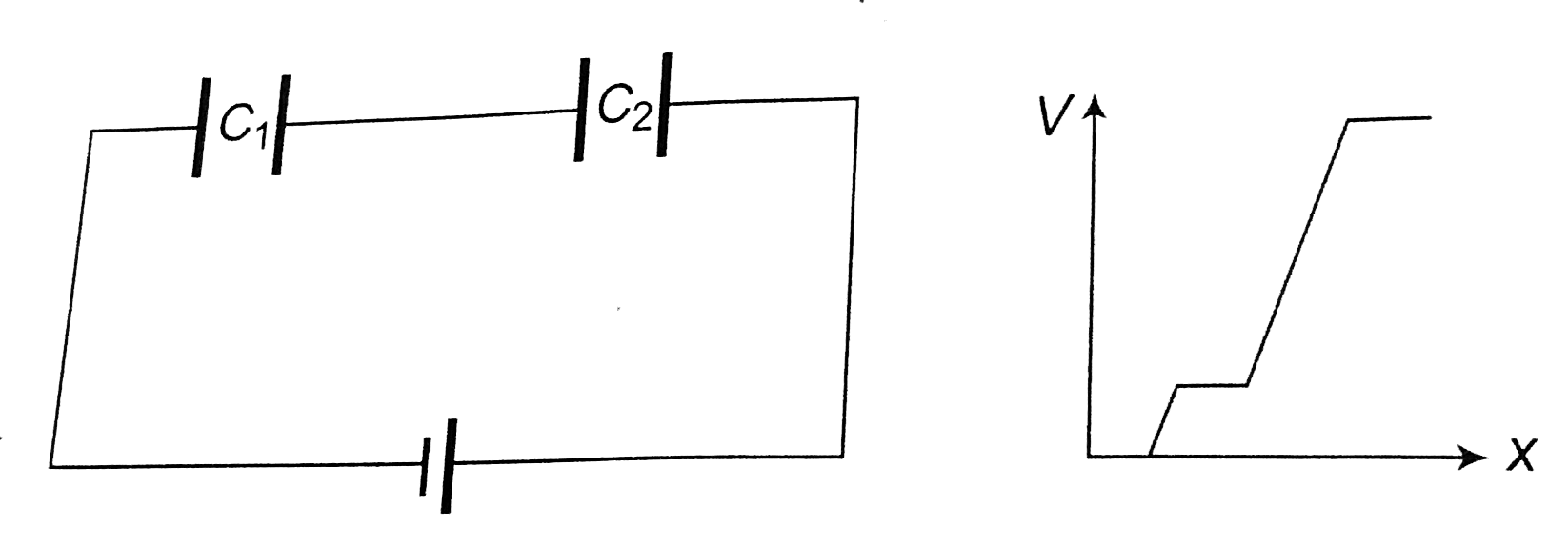 03:03View Solution
03:03View SolutionTo form a composite `10muF,200V` capacitor from a supply of idential capacitors marked `10muF,50V`, we require a minimum number of capacitors
03:42View SolutionA capacitor of capacitance `C_(1)=1 muF` can withstand maximum voltage `V_(1)=6 kV` and another capacitor of capacitance `C_(2)=3 muF` can withstand maximum voltage `V_(2) 4 kV`. When the two capacitors are connected in series, the combined system can withstand a maximum voltage of
03:22View SolutionThree capacitors each of capacitance `C` and of breakdown voltage `V` are joined in series. The capacitance and breakdown voltage of the combination will be
02:23View SolutionThe capacities of two parallel plate capacitors are `C_(1)` and `C_(2)` and their respective potential are `V_(1)` and `V_(2)`. If they are connected by a thin wire, then
(A) Commen potential will be `(C_(1)V_(1)+C_(2)V_(2))/(C_(1)+C_(2))`, if plates of same polarities are connected together
(B) Loss of energy will be `(1)/(2)(C_(1)C_(2))/(C_(1)+C_(2))(V_(1)-V_(2))^(2)`, if plates of same polarities are connected together
(C) Common potential will be `(|C_(1)V_(1)-C_(2)V_(2)|)/(C_(1)+C_(2))`, if plates of opposite polarities are connected together09:49View SolutionA capacity of capacity `C_(1)` is charged up to `V` volt and then connected to an uncharged capacitor of capacity `C_(2)`. Then final potential difference across each will be
01:39View SolutionTwo identical capacitors, have the same capacitance C. One of them is charged to potential `V_1` and the other `V_2`. The negative ends of the capacitors are connected together. When the poistive ends are also connected, the decrease in energy of the combined system is
07:33View SolutionTwo metallic spheres of radii `1 cm` and `2 cm` are given charges `10^(-2) C` and `5 xx 10^(-2) C` respectively. If they are connected by a conducting wire, the final charge on the smaller sphere is
03:11View SolutionA battery of `20V` is connected to a capacitor of capacitance `10 muF`. Now battery is removed and this capacitor is connected to a second uncharged capacitor. If the charge distributes equally on these two capacitors, the total energy stored in the two capacitors will be
03:36View SolutionA metallic sphere of radius `R` having charge `Q` is connected to an uncharged sphere of radius `3R`. The amount of charge flown through connecting wire is
02:42View SolutionA condenser of capacity `C_(1)` is charged to a potential `V_(0)`. The electrostatic energy stored in it is `U_(0)`. It is connected to another uncharged condenser of capacity `C_(2)` in parallel. The energy dissipated in the process is
03:46View SolutionA parallel plate capacitor of capacitance C is connected to a battery and is charged to a potential difference V. Another capacitor of capacitance 2C is ismilarly charged to a potential difference 2V. The charging battery is now disconnected and the capacitors are connected in parallel to each other in such a way that the poistive terminal of one is connected to the negative terminal of the other. The final energy of the configuration is
06:15View SolutionA `2muF` capacitor is charged as shown in the figure. The percentage of its stored energy disispated after the switch S is turned to poistion 2 is
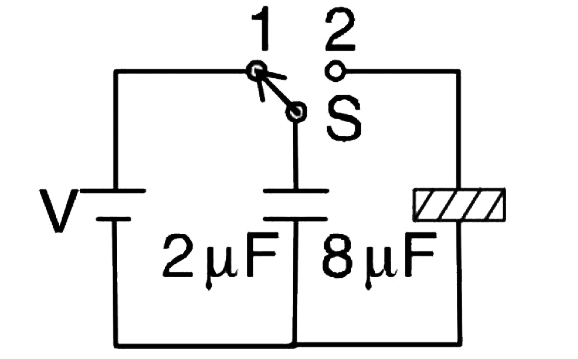 02:45View Solution
02:45View SolutionTwo conducting spheres of radii `r_(1)` and `r_(2)` having charges `Q_(1)` and `Q_(2)` respectively are connected to each other. There is
06:29View SolutionA conducting sphere of radius `10 cm` is charged `10 muC`. Another uncharged sphere of radius `20 cm` is allowed to touch it for some tome. After that if the sphere are separted, then surface density of chsrges, on the spheres will be in the ratio of
03:24View SolutionTwo capacitors of capacitances `3muF` and `6muF` are charged to a potential of `12V` each. They are now connected to each other, with the positive plate of each joined to the nagative plate of the other.
(A) the common potential will be `12V`
(B) the loss in energy will be `576muJ`
(c) the common potential will be `4V`
(D) the loss in energy will be `144 muJ`08:06View SolutionTwo capacitor of capacitance `5 muF` and `10 muF` are charged to potential `40V` and `10V` respectively. Now the two capacitors ate connected with plates of same polarities together .
(A) the common potential will be `20V`
(B) the final charges of capacitors will be `100muC` and `200muC`
(c) the ratio of total energy stored in capacitors before and after connection is `3:2`
(D) the loss energy of system is `1500muJ`09:20View SolutionThree capacitors of capacitances `3 muF, 9 muF` and `18 muF` are connected in series across a `120V` supply line. The Charged capacitors are then disconnected from the line and reconnected with plates of same polarities together and n0-external voltage. the charge on `3 muF` is
08:32View SolutionIn the given circuit if point `C` is connected to the earth and a potential of `+80V` is given to the point `A`, the potential at `B` is
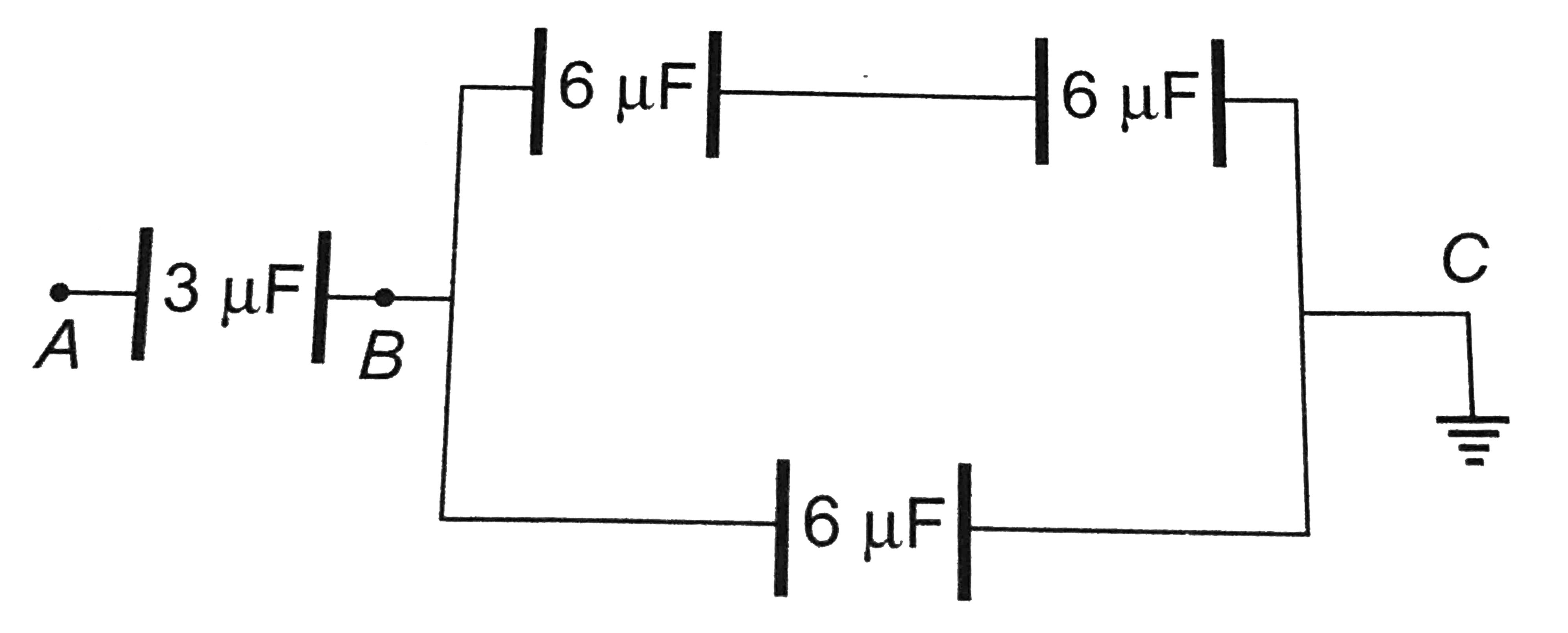 03:05View Solution
03:05View SolutionTwo capacitors `C_(1)` and `C_(2)` in a circuite are joined as shown. If `V_(A)=V_(1),V_(B)=V_(2)`, the potemntial of point `P` is
 04:08View Solution
04:08View Solution`1000` small water drops each of raius `r` and charge `q` coalesce together to form one spherical drop.
(A) the ratio of capacitances of big and small drop is `10`
(B) the ratio of potential of big and small drop is `100`
(c) the ratio of surface charge densities of big and small drop is `10`
(D) the ratio of energy stored of big and small drop is `10^(5)`06:55View SolutionA battery is used to charge a parallel plate capacitor till the potential differece between the plates becomes equal to the electromotive force of the battery. The ratio of the energy stored in the capacitor and the work done by the battery will be
02:34View SolutionAn unchanged capacitor is connected to a battery. On charging the capacitor
(A) All the energy supplied is stored in the capacitor
(B) half the energy supplied is dissipated in form if heat in connecting wire
(D) the energy stored depends upon the time for which the capcitor is charged03:33View SolutionA parallel plate air capacitor is connected to a battery. The quantities charge, voltage, electric field and energy associated with this capacitor are given by `Q_0` , `V_0`, `E_0` and `U_0` respectively. A dielectric slab is now introduced to fill the space between the plates with battery still in connection. The corresponding quantities now given by Q, V, E and U are related to the previous one as
04:38View Solution`C,V,U` and `Q` are capacitance, potential difference, energy stored and charge of parallel plate capacitor respectively. The quantities that increase when a dielectric slab is introduced between the plates without discounting the battery are
04:32View SolutionA parallel plate capacitor is connected to a cell. A metal plate of neglible thickness is inserted parallel to plates.
(A) the capacitance remains same
(B) the cell will supply more charge
(c) Equal and opposite charges will appear pm two faces of metal plate
(D) the potential difference between the plates will increase05:35View SolutionThe capcitance of a parallel plate capacitor is `C_(0)` when the space between the plate is vacuum. Now this space is filled by a slab of dielectric constant `K`. The capacitor is connected to a battery emf `V` and the slab is taken out.
(A) Charge `(K_1)C_(0)V` flow through the battery
(B) Energy `(K-1)C_(0)V^(2)` is absorved by the cell
(c) The external agent has to do `(1)/(2)(K-1)C_(0)V^(2)` amount of work to take the slabe out
(D) the heat produced in connecting wires is `(1)/(2)(K-1)C_(0)V^(2)`06:25View SolutionThe separation between the plates of a parallel plate capacitor is made three times while it remains connected to a battery
(A) the battery absorbs some energy
(B) the electric field between plates remains same
(c) the charge on the capacitor decrease by `66.7%`
(D) some work has to be done by an external agent on the plates05:08View SolutionA parallel plate capcitor of capacitance `C` is having charge `q_(0)` on each plate. Now it is connected to a battery of emf `V`.
(A) The battery supplies charges `+CV` and `-CV` to two plates
(B) The outer surface of the plates have equal charges `q_(0)`
(c) The facing surface have equal and opposite charges of magnitude `CV`03:43View SolutionTwo idential parallel plate capacitors are connected in sereis to a cell of `120V`. A dielectric slab `(K=3)` in placed in one of the capacitor. The p.d., across the capacitors will now be
03:01View SolutionTwo condensers, one of capacity `C` and the other of capacity `C//2`, are connected to a `V` volt battery, as shown
The heat produced in connecting wires
 03:16View Solution
03:16View SolutionTwo capacitors `C_(1)=3muF` and `C_(2)=6muF` in series, are connected in parallel to a third capacitor `C_(3)=4muF`. This arrangement is then connected to a battery of e.m.f., =`30V`, as shown. The energy lost by the battery in charging the capacitors
 02:32View Solution
02:32View SolutionTwo condensers of capacity `C` and `2C` are connected in parallel and these are charged upto `V` volt. If the battery is removed and dielectric medium of constant `K` is put between the plates of first condenser, then the potential at each condenser is.
03:05View SolutionThe plates of a parallel plate capacitor are charged up to `100 v`. Now, after removing the battery, a `2 mm` thick plate is inserted between the plates Then, to maintain the same potential deffernce, the distance betweem the capacitor plates is increase by `1.6 mm`. The dielectric canstant of the plate is .
02:50View SolutionAn isolated charged capacitor with vacuum between its plates is dipped into an oil tank. If the oil is pumped out, the electric field between the plates of capacitor will
03:30View Solution`C,Q,V` and `U` are capacitance, charge, potential difference and energy stored in an isolated parallel `1` plate capacitor respectively. Now a dielectric slab is placed between plates of capacitor, the quantities that decreases
04:56View SolutionA parallel plate capcitor has plate area `A` and separation `d`. It is charged to a potential difference `V_(0)`. The charging battery is disconnected and the plates are pulled apart to three times the initial separation. The work required to separate the plates is
04:13View SolutionThe space between plates of a parallel plate capacitor is filled by a dielectric and it is charged and then battery is removed. Now dielectric slab is slowly drawn out of the capacitor parallel to the plates. The variatiton of the potential of capacitor with respect to the length of the dielectric plate drawn out is
06:29View SolutionA parallel plate capacitor of plate area A and plate separation d is charged to potential difference V and then the battery is disconnected. A slab of dielectric constant K is then inserted between the plates of the capacitor so as to fill the space between the plates. If Q, E and W denote respectively, the magnitude of charge on each plate, the electric field between the plates (after the slab is inserted), and work done on the system, in question, in the process of inserting the slab, then
05:14View SolutionA parallel-plate capacitor has plates of area `A` and separation `d` and is charged to a potential difference `V`. The charging battery is then disconnected, and the plates are pulled apart until their separation is `2d`. Derive expression in terms of `A, d` and `V` for
(a) the new potential difference
(b) the initial and final stored energies, `U_i` and `U_f` and
(c) the work required to increase the separation of plates from d to `2d`.03:29View SolutionA parallel plate capacitor of capacitance `10muF` is charged to potental `50V` and then isolated.
(A) After filling the space by a dielectric slab, the potential of capacitor becomes `25V`. The dielectric constant is `2`
(B) If plate separation is reduced to half, the potential of capacitor become `25V`
(c) The force between plates after indriduction of dilectric or after change in separation between plates remains same05:58View SolutionFigure shows two identical parallel plate capacitors connected to a switch `S.` Initially ,the switch is closed so that the capacitors are completely charged .The switch is now opened and the free space between the plates of the capacitors is filled with a dielectric of dielectric constant 3. Find the ratio of the initial total energy stored in the capacitors to the final total energy stored.
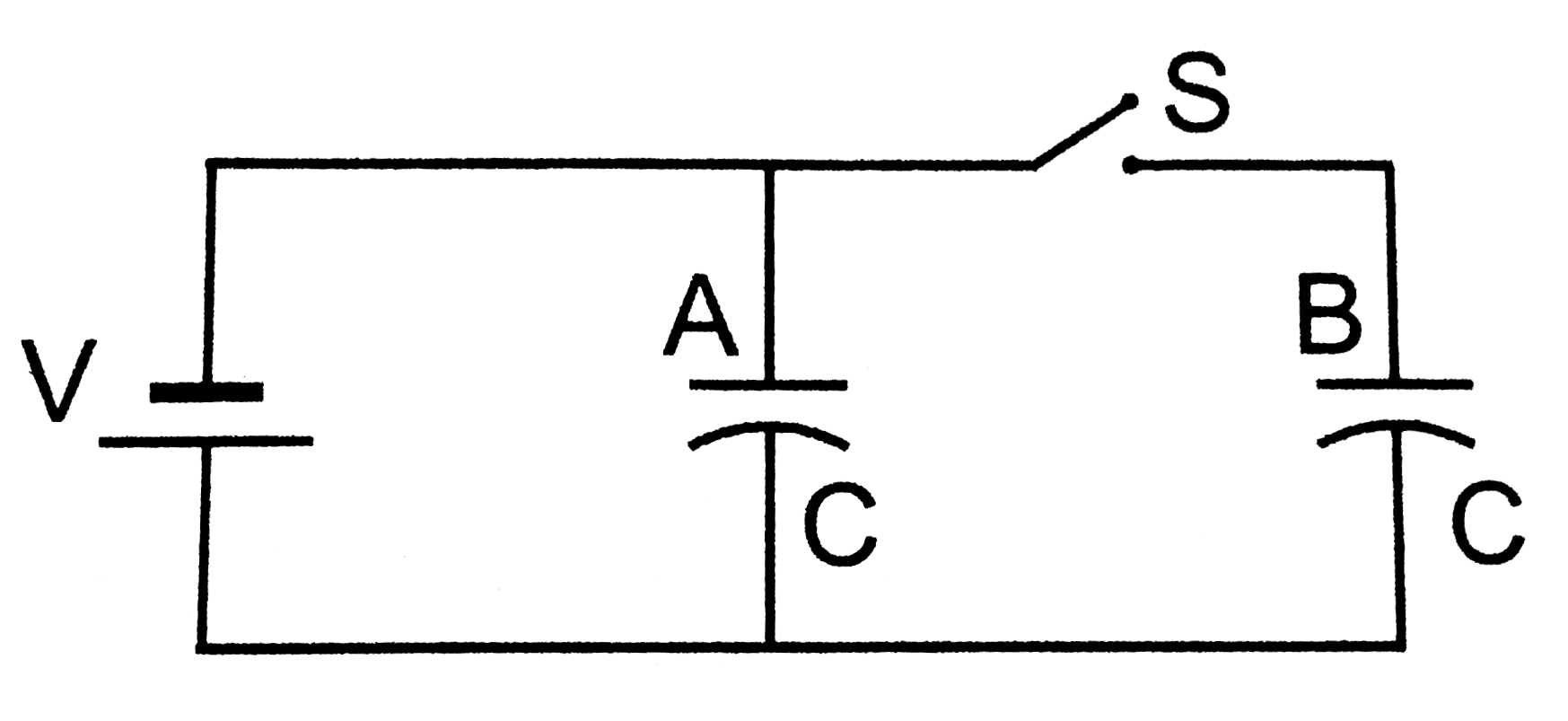 05:47View Solution
05:47View SolutionConsider the situation shown in the figure. The capacitor `A` has a charge `q` on it whereas `B` is uncharged. The charge appearing on the capacitor `B` a long `7` time after the switch is closed is :
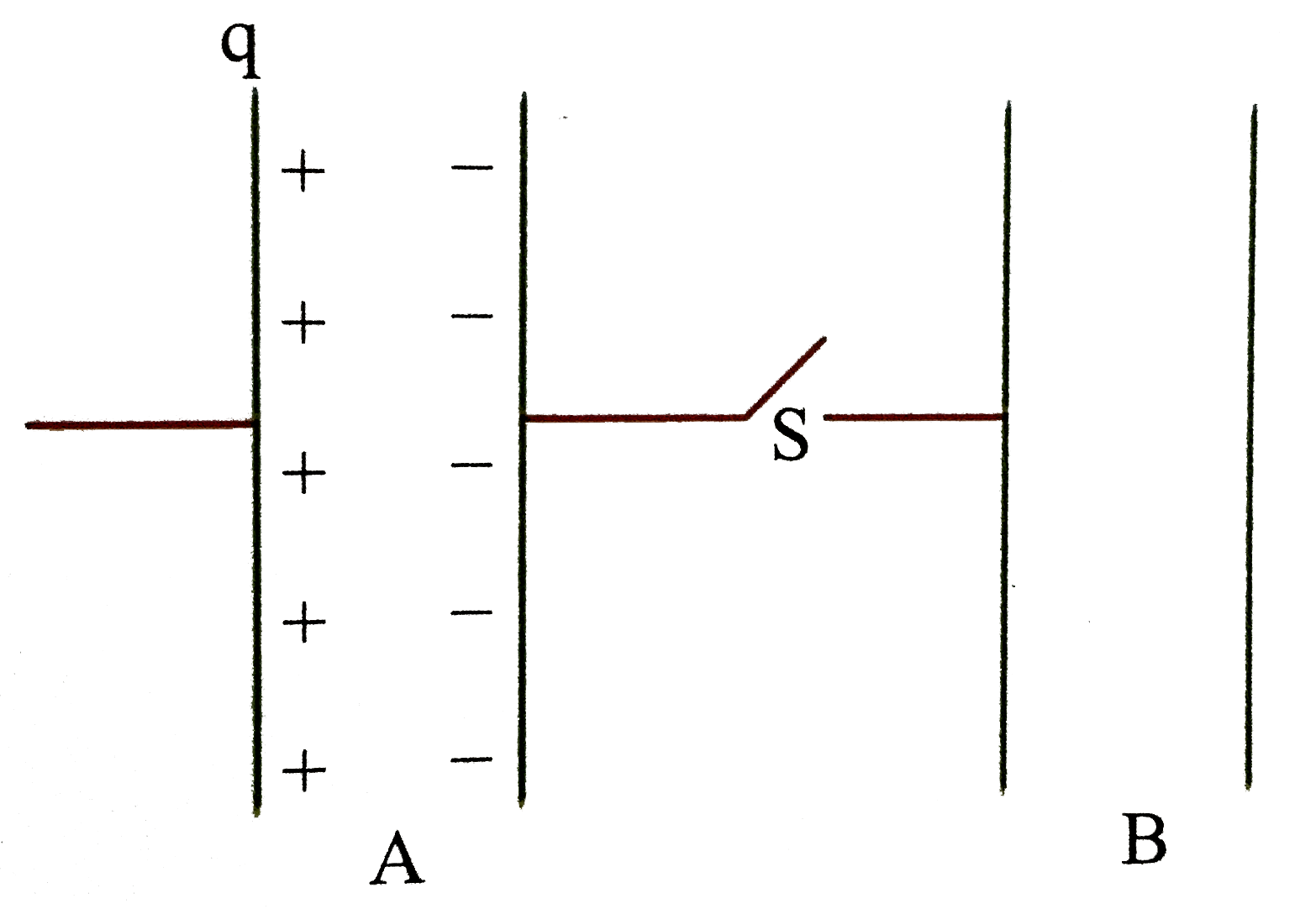 .02:40View Solution
.02:40View SolutionTwo thin dielectric slabs of dielectric constants `K_(1)` and `K_(2) (K_(1) lt K_(2))` are inserted between plates of a parallel plate capacitor, as shown in the figure. The variation of electric field `E` between the plates with distance `d` as measured from plate `P` is correctly shown by
 03:39View Solution
03:39View Solution
Exercise questions and complete solutions for chapter CAPACITANCE of CP SINGH PHYSICS (HINGLISH) of Class 12
